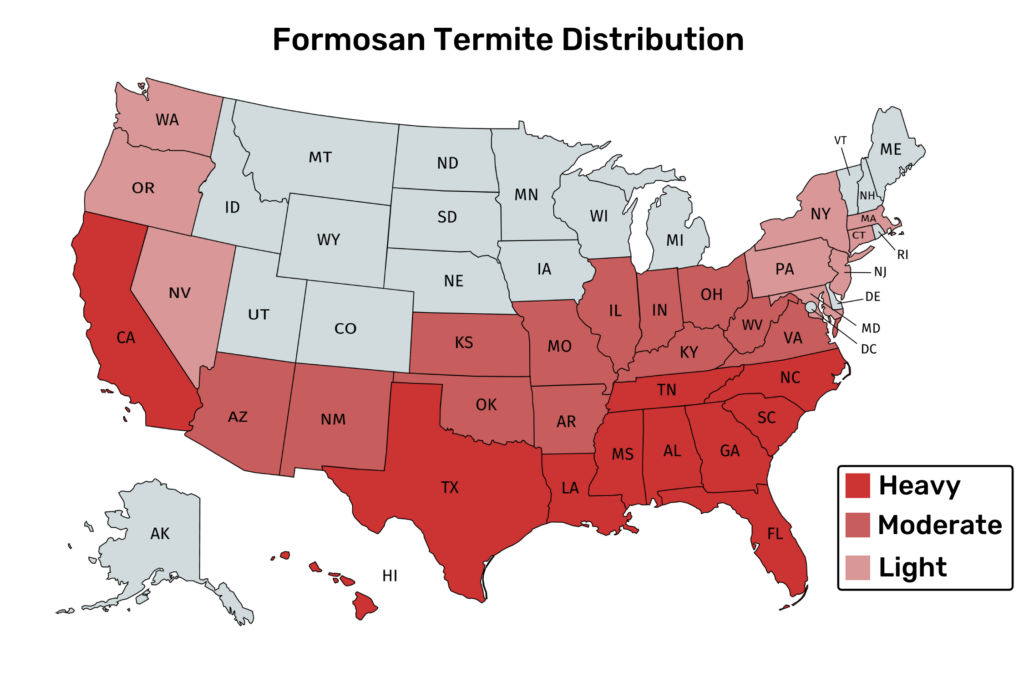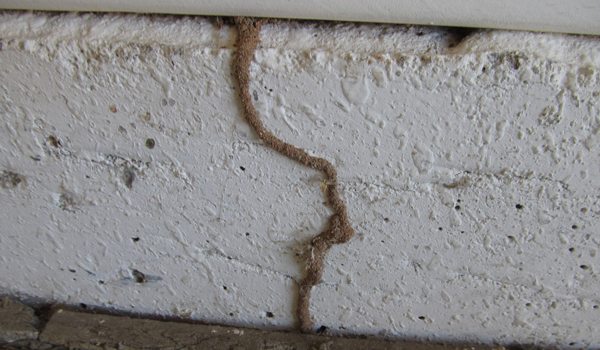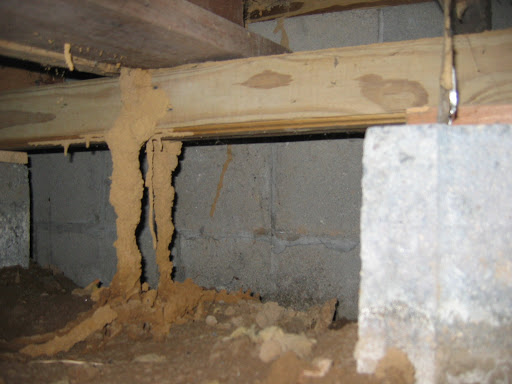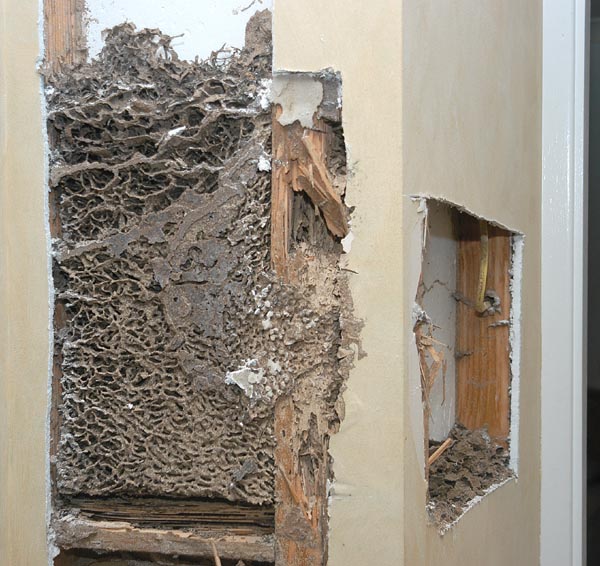Termites cost homeowners in the U.S. over 5 billion dollars each year.
And according to the USDA, homeowners spend at least 2 billion dollars on Formosan termites damage alone.
Formosan colonies can reach up to one million termites and can cause damage rather quickly.
If you suspect or determine that you have a Formosan termite infestation in your property, you must act quickly.
In this article, we’ll go over everything you need to know about Formosan termite infestation, from identification to prevention.
1. How To Identify Formosan Termites?
Formosan Termites are a type of Subterranean termite.
Like all Subterranean termites, Formosan Termites require contact with the soil to survive.
They live underground and use mud tubes to travel from their nest to food.
Formosan Termites are unique from other subterranean termites in that they create secondary nests.
These nests are often called carton nests and are constructed with saliva, wood, and excrement.
Formosan Termites secondary nests allow them to maintain a moist environment above ground.
If you have a Formosan termite infestation, you’ll likely find these “carton” nests inside your walls.
Formosan termites are found across the US.

But they are more concentrated in southern states, including South Carolina, Mississippi, Georgia, Florida, Alabama, Louisiana, and Tennessee.
What do Formosan termites look like?

Within Formosan termite colonies are three castes: workers, soldiers, and reproductives.
The reproductives, known as Alates, are about 14-15mm in length if you include their wings.
They have pale yellow to brownish-yellow bodies and translucent wings.
Formosan termite workers have creamy, white bodies and dark brown heads with two sharp pincers.
Their soldiers have oval-shaped heads with large mandibles.
They also have a narrower pronotum that their head.
Formosan termites have white bodies with a darker orange or yellowish head.
Signs of Formosan Termite Infestation
The most common way to inspect for Formosan termites is to look for visual signs.
One of the easiest ways to determine if you have a Formosan termite infestation is the presence of mud tubes.
Subterranean termites create mud tubes to help protect them when traveling between food and the nest.
These mud tunnels take on different forms: working tube, exploratory tube, and drop tubes.
The working tube and exploratory tube look like veins running up against your wall.

Drop tubes look like calcium deposits that hang in caves. Except they hang from the ceiling.

Formosan termites also commonly use mud as cement to cover up small holes or damage in walls.
Another excellent way you can determine if you have Formosan termites are carton nests.
Formosan Termites are unique from other subterranean termites in that they create secondary nests, known as carton nests.

Carton nests allow Formosan termites to maintain moisture above ground.
In some cases, they can use the carton nest as their primary nest and only forage in the soil on rare occasions.
Unfortunately, these are hard to find unless you tear your walls down.
You can also go around your house and look for the following evidence:
- Damaged wood
- Termite Galleries with soil inside. Damage is typically along the grain of the forest.
- Discarded termite wings
- Uneven or Bubbling Paint
- Flying termites in your home
- Hollow wood
2. How to Treat Formosan Termites?
The best treatment for Formosan termites will be a combination of chemical soil treatment and localized wood treatment.
The soil treatment will eliminate Formosan termites living in soil, while the spot treatment will target the ones inside the walls.
1. Chemical Soil Treatment
Chemical soil treatment is the best line of attack against Formosan termites and any other subterranean termites.
To do this, make a trench about 6×6 inches wide around the foundation of your home.
Be careful not to damage any pipes or sprinkler lines.
Next, pour liquid insecticide or termiticide into the trench.
Once the soil absorbs the liquid, it will act as a barrier to prevent any termites from entering your home.
One of the most popular liquid termiticides to use for chemical soil treatment is Termidor.
Termidor has been shown to have a 99% mortality rate against Formosan termites.
I also highly recommend that you also drill any concrete slaps around your home or into your foundation.
Getting underneath your foundation is especially important if you have a basement foundation or if there are cracks in your foundation.
Likewise, you should also treat any concrete slabs such as patios and driveways.
Concrete slabs should be sprayed around the edges every 6-12 inches.
Inject soil through the soil for about 3-5 seconds.
After drilling holes into the concrete, be sure to cover holes either with a rubber filling or premade concrete.
Your soil treatment will target any termites under the ground and also act as a preventative treatment by keeping termites away.
Any termites that tunnel through the treated soil will die.
2. Foam Injection
The best way to treat termites inside your walls and wood is to inject them with foam.
Injecting foam termiticide allows you to treat deep into your walls and into termite galleries.
Any walls where there are mud tubes, termite damage, or termite galleries should be injected.
It is possible that Formosan termites construct a secondary nest inside the walls of your home.
If not treated, these secondary nest will allow them to continue reproducing.
To apply either foam treatment, drill into the wood until you feel less resistance.
This hollow area is where the termite gallery is.
Drill holes every 6-12 inches across the entire wood and inject them with pesticides.
Reapply treatment every three months for the best results.
3. Bait Stations
If you prefer not to pour chemicals into your soil, this method may work better for you.
Bait prevention involves placing termite baits into the ground.
The idea is to get the termites to ingest and share the bait with their colony.
The termites will then gradually die in the process.
To increase the odds of termites ingesting your bait, I recommend placing the bait 10 to 15 feet apart.
Place the bait around the perimeter of your home and near previous termite damage.
It’s also important that you don’t add termiticide right away.
First, you’ll want to establish the eating habits for the termites.
This process is called pre-baiting.
Pre-baiting allows the scout termite to find and feed on the bait safely.
The scout termite will then leave a scent trail for other worker termites to follow and feed on the bait.
Once you have a feeding cycle between the scout and worker termites, you can proceed to replace the wood with a toxic substance.
The worker termites will then feed on the bait and bring the poison to the entire colony.
One disadvantage of bait is that they work much slower than liquid insecticides.
It may take several weeks before the termites find the baits. And even longer for them to transfer it to the rest of the colony.
In that process, some degree of damage may occur.
That said, bait prevention can be useful in cases where it’s not possible to use liquid insecticide.
For instance, if you live near drainage systems and steams, using liquid treatment may not be an option.
Bait Stations are also an effective way to monitor and track termite activity after your initial.
You can place cellulose materials into the ground without termiticide to determine if you have any termites.
3. How to Prevent Formosan Termites?
To prevent termites, make sure you:
- Properly Store your Firewood
Formosan termites thrive on firewood.
While they live in the soil, their workers will penetrate and feed into firewood.
Do not stack firewood against your house. Doing so will give termites an easy way to expand their feeding into your home.
Make sure to keep them away from your home and at least a few inches off the ground.
- Install Bug Screens
Install bug screens over attic vents to prevent entry.
- Ventilate Properly
Termites flourish in damp and moist areas.
Ventilate your home to prevent them from becoming too humid.
- Replace All Damaged or Rotting Wood.
Formosan termites love damaged or rotting wood because they are easy to penetrate and eat.
Keep them away, remove all damaged or rotting wood, and replace them with wood that’s treated with pesticides.
- Maintain Landscape
Remove all plants and mulch away from the foundation of your home.
- Apply Fresh Paint
Chipped Paint and small holes allow termites to penetrate wood easily, so make sure to seal them.
- Avoid Using Mulch
Mulch provides termites with the perfect shelter and source of food.
It traps moisture and insulates against harsh temperatures. It’s also often made of cellulose, which termites need to survive.
To keep termites away, minimize the use of wood mulch in your home.
Or use mulch that naturally repels termites such as redwood, melaleuca, cypress, and cedar mulch to prevent attracting termite.
Another alternative you can use is rock, gravel, pebbles, rubber, and pine needles.
Finally, make sure you keep mulch away from your wood siding, door, window framing, and foundation.
- Eliminate Excess Moisture
To prevent termites, make sure to keep moisture away from your home with proper drainage systems.
- Eliminate Soil to Wood Contact
Remove any soil-to-wood contact in your home. Make sure your wood sidings, fences, decks, doors, and window framing are not touching the soil.
Resources: 16 Termite Prevention Tips
Frequently Asked Questions (FAQ)
Subterranean Termites vs Formosan Termites
The easiest way to know if you have Formosan termites is the presence of carton nests.
Carton nests are unique to Formosan Termites.
These nests, known as secondary nests, are constructed by Formosan termites with saliva, wood, and excrement.
The nests allow them secondary to maintain a moist environment above ground.
If you have a Formosan termite infestation, you’ll likely find these “carton” nests inside your walls.
Subterranean termites and Formosan termites are also different in appearance.
Soldier Formosan termites have an oval-shaped head while native subterranean termites have rectangular heads.
Their reproductives are also different.
Formosan winged termites have brown bodies, while native subterranean termites are black.
Resource: Ultimate Guide for the Different Types of Termites
Formosan Termites vs. Drywood Termites
The easiest way to know if you have Formosan termites is the presence of carton nests.
Formosan termites are the only type of termite that builds this nest.
Drywood termites are also distinct from Formosan termites in that they do not live in the soil but deep inside the wood.
Formosan termites are also different from Drywood termites in appearance.
Soldier Drywood termites have larger heads with a broader set of mandibles compared to Formosan soldier termites.
Formosan soldier termites are also typically lighter and smaller than Drywood soldier termites.
Flying Drywood termites have dark brown to black bodies while Formosan termites are typically light brown.
Resource: Ultimate Guide for the Different Types of Termites
Where do Formosan Termites Live?
 Formosan termites live inside the soil. But they can also live in secondary nests, called carton nests.
Formosan termites live inside the soil. But they can also live in secondary nests, called carton nests.
You can find Formosan termites across the US.
But they are more concentrated in southern states, including South Carolina, Mississippi, Georgia, Florida, Alabama, Louisiana, and Tennessee.
Resource: Ultimate Guide for the Different Types of Termites
Do Formosan Termites Eat Concrete?
Formosan termites do not eat concrete.
They get their nutrition from cellulose. Since concrete doesn’t have this compound, it has zero nutritional value for termites.
Formosan termites, however, will crawl through existing cracks on concrete in search of cellulose.
These pests are tiny and can penetrate through the smallest holes and crevices.
If the concrete around your home has cracks or damage, they are vulnerable to termite invasion.
Resource: 5 Easy DIY Termite Treatment Methods (With Instructions)
How Much does Formosan Termite treatment cost?
Overall you can expect to pay around $2,000 for Formosan termite treatment.
But the exact price will depend on the level of infestation and the treatment used.
Chemical soil treatment costs generally cost around $5 – $12 per linear foot.
As a reference, a 2,000 square foot home will typically have a perimeter of 180 ft.
The price for a soil treatment will be between $900 and $2,160 on a slab foundation.
On average, the cost of Formosan termite soil treatment is around $1,250.
For localized treatments such as chemical or oil injection, you can expect to pay between $300 and $500 every 10 and 15 feet.
Do Formosan Termites eat Wood?
Like other types of termites, Formosan termites eat wood and other objects made of cellulose, such as paper, fabric, and cardboard.
Resource: 22 Things That Termites Eat Around Your Home
What is the Best Treatment for Formosan Termites?
The best treatment for Formosan termites will be a combination of chemical soil treatment and localized wood treatment.
The soil treatment will eliminate Formosan termites living in soil, while the spot treatment will target the ones inside the walls.
Spot treatment is vital in targeting any carton nest that Formosan termites might have created inside your wall.
Resources:
Formosan Termites: Identification, Treatment, and Prevention
